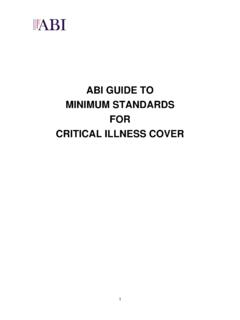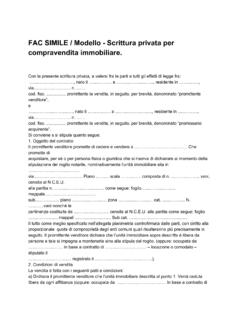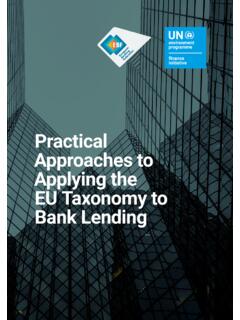Transcription of Addressing customer vulnerability: A guide to ... - Home ABI
1 @ british InsurersSection XXAddressing customer vulnerability: A guide to identifying and supporting vulnerable customers in the long term savings @ british InsurersAssociation of british @ british InsurersContents 3 Objective 4 Executive Summary 5 Background 8 Status & Scope 9 The Scale of Consumer Vulnerability in the UK 10 Principles of the guide 11 Section One: Identifying Vulnerable Customers 29 Section Two: Supporting Vulnerable Customers 45 ABI Vulnerability Working Party 46 ReferencesAbout the ABIThe association of british Insurers is the voice of the UK s world leading insurance and long term savings industry. A productive, inclusive and thriving sector, we are an industry that provides peace of mind to households and businesses across the UK and powers the growth of local and regional economies by enabling trade, risk taking, investment and innovation.
2 @ british InsurersObjectiveObjectiveThis good practice guide is designed to help firms operating in the long term savings market better understand, identify and support customers who may be vulnerable, to ensure all customers are supported through the whole customer journey. @ british InsurersExecutive Summary Executive Summar yRetirement can be complex for everyone. Freedom and choice in pensions carries risks for all customers, not least the risk of running out of money, as well as the ongoing risk of fraud and scams. Part of the challenge for industry and policy-makers in this market is to better understand the customer circumstances that create sufficient risk or vulnerability to require additional financial services, it is essential to understand how customers might be vulnerable and vulnerable to what, before determining what support is needed, and from whom.
3 Circumstances that might categorise someone as vulnerable can be temporary or sporadic states. Customers may not know they are vulnerable or be forthcoming in disclosing what can be very personal information, making it very difficult to identify that someone is vulnerable and to determine the appropriate ABI believes that to improve or introduce new processes for firms operating in the long term savings market, it is important to have a common understanding of what the best approaches to dealing with vulnerability are, which will in turn encourage the exchange of good practices from both inside and outside the industry. As the FCA s Occasional Paper No. 8 on vulnerability (OP8) states, the sharing of principles and good practice across all financial services is likely to lead to better outcomes 1.
4 We hope the guide achieves this, by building on previous initiatives and by offering a view of the unique challenges and opportunities faced by firms and their customers in the long term savings market. RECOMMENDATIONS 1. Firms will implement a vulnerability policy or strategy, if not already present, by January 2018. If one is already in place, firms will review and ensure their internal policies are fit for purpose based on the principles of this guide . 2. Firms commit to providing regular training to all relevant staff and will continue to raise awareness of vulnerability with colleagues across the business. 3. Firms continue to share examples of good practice through the ABI, to ensure the industry and its customers benefit from high levels of support, and therefore the guide will be kept continually under FCA, 2015, Occasional Paper No.
5 8: Consumer Vulnerability @ british InsurersBackgroundBackgroundThe question of how best to support vulnerable customers is an issue of continuing importance in all sectors. The period since the financial crisis of 2008 saw increased focus on how all businesses treat customers, but the publication of the OP8 was the first regulatory intervention to require financial services to reflect on current approaches to Addressing vulnerability. Published on 23 February 2015, OP8 aims to broaden understanding and stimulate interest and debate around vulnerability, and to provide practical help and resources to firms in developing and implementing a vulnerability strategy. Although OP8 focuses on vulnerable consumers in the context of consumer credit, the Paper s themes have a much wider application to other markets and products.
6 OP8 highlighted four key problem areas that the FCA identified as being present at every stage, from high-level policy, through system design, to the products that are available and ways that staff implement policies and sell products : Policy: lack of overarching vulnerability policy or strategy; stringent fraud prevention approaches that do not allow flexibility, even for legitimate third-party requests. Systems: poorly functioning systems that do not encourage joined-up information sharing or flagging; use of automation and online channels that may inhibit the identification of vulnerability. Products: complex and confusing communications; inflexible products designed for the average customer ; limitations around authorising third parties on behalf of customers. Implementation: gaps in staff training practices or lack of expertise; inconsistent customer service; lack of empathy; inconsistent interpretations of data protection measures around disclosure; inflexible arrangements for temporary delegation; potentially exploitative sales practices.
7 @ british InsurersBackgroundOP8 outlines a list of key themes for firms to explore in order to improve outcomes for all customers, but which will be particularly beneficial for vulnerable customers: the adoption of a consistent approach to vulnerability embedded across all operations; all relevant staff must be aware of the policy; ongoing evaluation of the effectiveness of a vulnerability strategy; frontline staff are adequately trained to facilitate sometimes difficult conversations with consumers and know where to find internal and external expertise; flexibility in the application of terms and conditions of products and services; an efficient process for referring consumers on to specialist teams; good policies and practice in handling disclosure or communication needs of consumers, recording and acting on them; clear, simple information and explanation throughout the product cycle; and, policies are not applied in an overzealous manner which can create problems for response, many sectors have since made positive strides in how they support all customers, particularly those who are potentially vulnerable.
8 A prominent example of this is the Vulnerability Taskforce, led by the british Bankers association (BBA), which produced its Improving outcomes for customers in vulnerable circumstances report2. Similarly, the ABI produced with the british Insurance Brokers association (BIBA) a Code of Good Practice regarding support for potentially vulnerable motor and household customers at renewal3. Over the same period, developments in the retirement market have created new challenges for all customers; challenges that may be more pronounced for those who are vulnerable. The introduction of pension flexibility has added complexity to decisions about when and how to access a pension, and which provider or investment options to choose. With this unprecedented flexibility, the new retirement landscape means that more consumers will make decisions about investments and withdrawals into their 70s and 80s.
9 Consequently there is a need for a focus on how vulnerable customers may, by nature, have alternative experiences or require alternative means of support. Two years on from OP8, vulnerability remains high on the regulatory and political agenda, with the recent publication of the FCA s Ageing Population Strategy and the FCA Mission Review which considers vulnerability within its future regulatory approach as well as the House of Lord s Financial Exclusion Committee4, which raises some important issues for all financial and utility services. As the ABI stated in its response to the Mission Review consultation, we believe that taken by itself, regulatory action cannot deliver a good outcome for the vulnerable in society or for the excluded, and a joined up approach with other Government authorities is required.
10 We look forward to engaging with policymakers on the issues relevant to providers and customers in the long term savings market, particularly regarding the overarching theme identified throughout this piece of work about the occasional rigidity of the existing legislative and regulatory frameworks. These are rightly there to protect consumers, but can sometimes hinder firms in how they support vulnerable customers. 2 BBA: Improving outcomes for customers in vulnerable circumstances 3 ABI & BIBA Code of Good Practice regarding support for potentially vulnerable motor and household customers at renewal: 4 Select Committee on Financial Exclusion: Tackling financial exclusion: A countr y that works for ever yone? @ british InsurersSection XXThe @ british @ british InsurersThe guideStatus & ScopeThis guide sets out principles, good practice and case studies to help long term savings firms understand how they can better identify and support vulnerable customers, both at the point of purchase and throughout the life of the guide is not limited to a set of specific products, as it could be applied to other cohorts of a firm s client base or touchpoints in a person s life.









